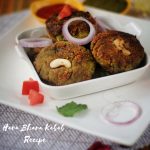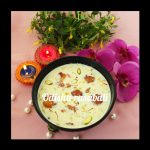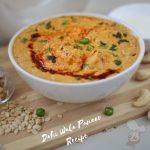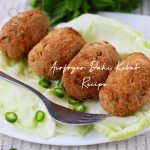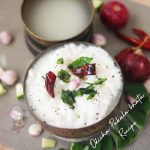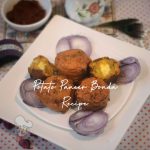Enjoy this lip-smacking dhai bhara aloo dum with ghugni on a chilly evening with your friends and family. This tantalizing combination would take your taste buds on a roller coaster ride and your palates would want for more in every bite..
Dive Into:
"Relish the food with a little bit of its history"
1. Dahi Bhara Aloo Dum
2. A Prelude On Dahibhara Aloodum
3. Origin And Story Of Dahi Bhara Aloo Dum
4. Prevalence And Fame Of Dahibhara Dum Aloo
5. Needed Ingredients To Make DahiBhara Dum Aloo
6. Step wise Directions To Make Dahibhara Dumaloo
7. Points To Ponder
8. Faqs
9. Dahi Bhara Dum Aloo In A Nutshell
10. Tantalizing Trappings With Dahibhara Dum Aloo
11. Alluring Ambience You Would Enjoy
12. Nutritional Value
Odisha is a state located in eastern India, known for its rich cultural heritage and diverse cuisine. One of the most popular aspects of Odia cuisine is its street food, which is a mix of flavors and textures that reflects the state's varied history and influences. Dahi Bara Aloo Dum features deep-fried lentil dumplings soaked in tangy yogurt and served with spicy potatoes. It's a popular street food that is often enjoyed as a snack or light meal.
A Prelude On Dahibhara Aloodum:
Dahibhara Aloo Dum is a popular street food of Odisha, a state located in eastern India. This dish is a combination of two separate dishes - Dahibara and Aloo Dum - that are often served together. Dahibara is a deep-fried lentil dumpling that is soaked in tangy yogurt, while Aloo Dum is a spicy potato curry that is often served as a side dish.
To make Dahibhara Aloo Dum, the Dahibara is first prepared by mixing ground lentils with spices and shaping them into small balls, which are then deep-fried until golden brown. These fried dumplings are then soaked in a mixture of yogurt, water, and spices, which gives them a tangy and refreshing flavor.
The Aloo Dum is made by cooking potatoes in a spicy tomato-based curry, which includes a variety of spices such as cumin, coriander, turmeric, and chili powder. The resulting dish is a hearty and flavorful accompaniment to the Dahibara, providing a balance of spiciness and tanginess.
Dahibhara Aloo Dum is a popular street food in Odisha and can be found in many small food stalls or carts throughout the state. It is often enjoyed as a snack or light meal, particularly during hot summer months when the cool, refreshing yogurt helps to beat the heat.
Origin And Story Of Dahi Bhara Aloo Dum:
The origin of Dahi Bhara Aloo Dum is believed to have originated in Odisha, a state in eastern India. The dish is a combination of two separate dishes - Dahibara and Aloo Dum - that are popular in the region.
Dahibara has been a part of Odisha cuisine since several decades and is believed to have originated in the Jagannath temple in Puri, Odisha. According to legend, the dish was first made as an offering to Lord Jagannath, the presiding deity of the temple. Over time, Dahibara became a popular street food in the state and can now be found in many small food stalls or carts throughout Odisha.
Aloo Dum, on the other hand, is a spicy potato curry that is popular throughout India. It is believed to have originated in the northern state of Uttar Pradesh but has since spread to other parts of the country, including Odisha. In Odisha, Aloo Dum is often served as a side dish with various types of bread or rice.
The combination of Dahibara and Aloo Dum is believed to have been created in Odisha as a way to provide a complete and satisfying meal to people on the go. The cool and refreshing yogurt in the Dahibara helps to balance out the spiciness of the Aloo Dum, making it a popular street food that is enjoyed by people of all ages.
Today, Dahibhara Aloo Dum continues to be a popular street food in Odisha and can be found in many cities and towns throughout the state. Its unique blend of flavors and textures has made it a beloved dish among locals and tourists alike.
Prevalence And Fame Of Dahibhara Dum Aloo:
Dahibhara Aloo Dum has remained a popular street food in Odisha and its popularity and demand have only increased in the present decade. The dish is still widely available in small food stalls or carts throughout the state and has even gained popularity in other parts of India and abroad.
One reason for the continued popularity of Dahibhara Aloo Dum is its unique blend of flavors and textures. The cool and refreshing yogurt in the Dahibara helps to balance out the spiciness of the Aloo Dum, making it a delicious and satisfying dish that is enjoyed by people of all ages.
In recent years, there has also been a growing interest in local and regional cuisines across India, and Dahibhara Aloo Dum has become a popular dish to showcase the flavors and culinary traditions of Odisha. Many restaurants and food festivals now feature the dish on their menus, which has helped to increase its visibility and demand.
Moreover, with the rise of social media and food blogging, Dahibhara Aloo Dum has gained popularity among food enthusiasts who are eager to discover new and unique dishes from different parts of India. As a result, the dish has gained a loyal following and is often considered a must-try for anyone visiting Odisha.
To sum up, the popularity and demand for Dahibhara Aloo Dum have only increased in the present decade, cementing its place as one of the most iconic street foods of Odisha.

Needed Ingredients To Make DahiBhara Dum Aloo:
Dahi Bhara:
- Urad Dal: Basic ingredient to make the lentil balls for frying.
- Yogurt: A tangy and refreshing dairy product that is used to soak the dahibhara and to make the accompanying sauce.
- Cumin: An aromatic spice that is commonly used in Indian cuisine and adds a warm and earthy flavor to the dish.
- Turmeric: A bright yellow spice that is often used for its color and adds a mild flavor to the dish.
- Chili Powder: A spicy and pungent spice made from ground chili peppers that is used to add heat to the dish.
- Chat Masala: A versatile ingredient to add flavor.
- Ginger: A flavor enhancer that adds taste and digestive properties to food.
- Green Chili: The most common ingredient used to spice up the dish.
Dum Aloo:
- Potatoes: The main ingredient of the dish, which are boiled and then cooked in a spicy gravy.
- Onion - It is one of the basic ingredients to make dahi bhara dum aloo.
- Cooking Oil - Groundnut oil or mustard oil is used to temper the ingredients.
- Cumin Seeds- It is the common ingredient used for tempering several North Indian dishes.
- Bay Leaf_ It is frequently used in Indian cooking to add flavor.
- Cinnamon- It is also added to enhance taste and aroma.
- Red Chili Powder_ It is the base spice to spruce up any dish.
- Coriander Powder_ It is always added for taste and flavor and it goes together with the red chili powder.
- Turmeric Powder- It is one of the indispensable ingredient in the Indian kitchen that act as antibiotic.
- Asafoetida Powder_ It aids digestion apart from adding flavor to the dish.
- Cumin Powder- It is one of the essentials in the North, that adds a flavor and also aids digestion.
Step wise Directions To Make Dahibhara Dumaloo:
For Dahibhara:
Step 1: Make the urad dal batter along with the spices.
Step 2: Make patties out of it.
Step 3: Whisk yogurt and add the spice powders and salt.
Step 4: Soak the lentil fritters in the yogurt mixture.
For Dum Aloo:
Step 1: Heat oil and do the tempering with cumin seeds, asafoetida and other spices.
Step 2: Add the mashed potatoes with some salt and simmer until the gravy thickens.
For Serving:
Step 1: Place two lentil fritters in a serving bowl along with the yogurt mixture.
Step 2: Pour the aloo gravy over the fritters.
Step 3: Garnish with some fresh coriander leaves and serve.
Wash and soak the urad dal in water for at least 3-4 hours. Drain the water and grind the dal along with green chili, ginger, and salt to a smooth paste. Add a little water if required.

Heat oil in a deep pan for frying. Wet your hands with water and make small balls from the lentil paste. Gently drop them in hot oil and fry until golden brown. Drain on a paper towel to remove excess oil.



In a separate bowl, whisk the yogurt until smooth and dilute it with two cups of water. Add cumin powder, chaat masala, red chili powder, and salt. Mix well.
(Note: In this particular Odhisha recipe, the consistency of the curd mixture is comparatively thin)



Soak the lentil fritters in the yogurt mixture for about 10-15 minutes.



For the Aloo Dum, heat oil in a pan. Add cumin seeds, bay leaf, and cinnamon stick. Once they start to sizzle, add asafoetida, turmeric powder, red chili powder, coriander powder, and cumin powder. Stir well.



Add the onion, tomato and boiled potatoes and mix gently. Add water and salt, and simmer for 5-7 minutes until the gravy thickens.
To serve, place the soaked vada on a plate and pour some yogurt mixture over them. Top with the potato curry and garnish with chopped coriander leaves.



Points To Ponder:
Dos And Donts while making dahibhara Dum Aloo:
Do's:
- Do soak the lentils for at least 4-5 hours or overnight before making the dahibhara.
- Do make sure that the batter for the dahibhara is thick enough to hold its shape when dropped into hot oil.
- Do fry the dahibhara until they are golden brown and crispy.
- Do soak the fried dahibhara in water for a few minutes to make them soft and spongy.
- Do boil the potatoes until they are cooked through but still hold their shape.
- Do simmer the boiled potatoes in the gravy until they are coated with the sauce and the flavors are well combined.
- Do whisk the yogurt well before adding salt, sugar, and roasted cumin powder to make the dahibhara sauce.
Dont's:
- Don't make the batter for the dahibhara too thin or the dumplings may not hold their shape when fried.
- Don't overcook the potatoes or they may become mushy and fall apart in the gravy.
- Don't overcook the gravy or it may become too thick and dry.
- Don't forget to soak the fried dumplings in water before adding them to the yogurt sauce, as this is what makes them soft and spongy.
- Don't add too much salt to the dahibhara sauce, as the yogurt is already slightly sour and salty.
Faqs:
1. Is Dahibhara Aloo Dum vegan?
Yes, Dahibhara Aloo Dum can be made vegan by using plant-based yogurt instead of dairy yogurt and vegetable oil instead of ghee.
2. Is Dahibhara Aloo Dum gluten-free?
Yes, Dahibhara Aloo Dum is gluten-free as it does not contain any wheat or gluten-containing ingredients. However, it is important to ensure that the spices used are also gluten-free.
3. Where can I find Dahibhara Aloo Dum?
Dahibhara Aloo Dum is a popular street food dish in the Indian state of Odisha and can be found in street stalls and local restaurants in the region. It may also be available in some Indian restaurants outside of Odisha.
Dahibhara Dum Aloo In A Nutshell:
Nature: Dahibhara Aloo Dum is a vegetarian dish that is typically served as a snack or as a part of a meal.
Texture: The dish has a variety of textures, including crispy and spongy lentil dumplings, soft and creamy potatoes in a thick gravy, and a smooth and creamy yogurt sauce.
Consistency: The consistency of the dish is thick and creamy, with a balanced ratio of the dumplings, gravy, and sauce.
Flavor: Dahibhara Aloo Dum has a complex flavor profile that is both spicy and tangy, with notes of sweetness and earthiness. The dish is well-seasoned with a blend of aromatic spices, including cumin, coriander, garam masala, and turmeric.
Taste: The dish has a rich and flavorful taste, with a balance of savory and tangy flavors. The lentil dumplings are slightly sour and spicy, while the potatoes in the tomato-based gravy are savory and slightly sweet. The yogurt sauce adds a tangy and creamy flavor to the dish.
Tantalizing Trappings With Dahibhara Dum Aloo:
Chutneys: Mint chutney, tamarind chutney, and coriander chutney are some of the popular chutneys that are served with dahi bhalla and dum aloo.
Papad: Papads are thin, crispy, and savory discs made from lentils, chickpeas, or rice flour. They make a great accompaniment to dahi bhalla and dum aloo.
Rice: Steamed rice can be a great accompaniment to dum aloo, especially if the curry is thick and spicy.
Naan or Roti: Naan or roti are flat breads that can be served with both dahi bhalla and dum aloo. They are perfect for soaking up the flavorful curries.
Salad: A simple cucumber and tomato salad with a sprinkle of salt and lemon juice can be a refreshing accompaniment to these dishes.
Raita: Raita is a yogurt-based side dish that can be served with dahi bhalla and dum aloo. It can be made with cucumber, onion, tomato, or any other vegetable of your choice.
Pickles: Pickles are a common condiment in Indian cuisine. They can be made with mango, lime, or any other fruit or vegetable. They add a tangy and spicy flavor to the dishes.
Alluring Ambience You Would Enjoy:
Ambience: Dahi bhalla and dum aloo are great dishes for a casual and laid-back setting. You can enjoy them with your family and friends in a comfortable and cozy ambience, such as your home, a garden or a park. You can also consider a traditional Indian restaurant with a warm and inviting atmosphere.
Season: Dahi bhalla and dum aloo are perfect for any season, but they are especially enjoyable in the cooler months of the year. The comforting and warming nature of these dishes make them ideal for autumn and winter. They are also great for rainy days, as they provide a comforting and cozy feeling, The perfect ambiance and season to enjoy dahi bhalla and dum aloo is a cozy and relaxed atmosphere, with warm and comfortable surroundings, ideally in the cooler months of the year.
"Happy Cooking"
Ingredients
Directions
Wash and soak the urad dal in water for at least 3-4 hours. Drain the water and grind the dal along with green chili, ginger, and salt to a smooth paste. Add a little water if required.



Heat oil in a deep pan for frying. Wet your hands with water and make small balls from the lentil paste. Gently drop them in hot oil and fry until golden brown. Drain on a paper towel to remove excess oil.



In a separate bowl, whisk the yogurt until smooth and dilute it with two cups of water. Add cumin powder, chaat masala, red chili powder, and salt. Mix well.
(Note: In this particular Odhisha recipe, the consistency of the curd mixture is comparatively thin)



Soak the lentil fritters in the yogurt mixture for about 10-15 minutes.



For the Aloo Dum, heat oil in a pan. Add cumin seeds, bay leaf, and cinnamon stick. Once they start to sizzle, add asafoetida, turmeric powder, red chili powder, coriander powder, and cumin powder. Stir well.



Add the onion, tomato and boiled potatoes and mix gently. Add water and salt, and simmer for 5-7 minutes until the gravy thickens.
To serve, place the soaked vada on a plate and pour some yogurt mixture over them. Top with the potato curry and garnish with chopped coriander leaves.





